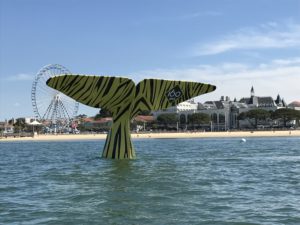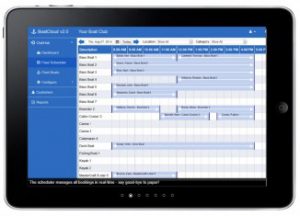Image via Wikipedia
We got this email from a reader, Stephen Aitken after he downloaded Jim’s e-book “Balance” from our store… get it and share with your coach and crew, it’s very good.
Hi Jim,
I have just downloaded your paper on balance – its very good.
I’m having an argument with one of my sons, Robert, who is a personal trainer (SC specialist) about the use of the balance board on land which I think should improve balance skills in the boat.
Balance boards have been criticized for not helping develop power and skills in sport in general see this and should only be used for rehabilitation. But I think they may help develop balance skills needed on the recovery which need reasonable core stability but fast response in the arms/hands and legs /feet. I’m not sure how the balance board should be used but probably circling round on the lip (the strengthen lower leg muscles and increase ankle flexibility in all dimensions) followed by balancing. Any views?
Jim Replies
Hi Stephen
I’ll reply at length later but, in brief, I’m in favour of balance boards. In particular, the small ones I’ve seen at Marlow (but not been able to find anywhere) are great for core stability – and as you say, especially in the recovery phase. I think that it would make for a great debate on the Rowperfect website.
Jim
So read the detail – and join the debate.. what do you think? Balance boards good or bad for rowing? Add your comments below please
Robert’s comments
I’m still not convinced that the [foot] stretcher is actually an unstable surface. The boat causes the instability and controlling this comes from your ability to work against rotational forces. Look up an exercise called the pallof press on YouTube. Suitcase deadlifts are also good for this.
I totally disagree with good balance requiring little strength.
Rapid firing of muscle fibres requires an athlete to be powerful. Power is directly related to maximum strength. If you train them to squat properly, deadlift properly etc you’ll get huge improvement in core strength and lower body power. Single leg exercises will develop the small stabilising muscles you are talking about as well as improving any imbalances between left and right legs. This will also aid balance in the distribution of force in the leg drive.
In addition, I think one of the key points is that unstable surfaces alter neuromuscular recruitment patterns. Its to different from what your body is doing in the boat and could impact performance negatively.
Stephen’s evidence
- Balance board – evidence for injury reduction, balance for elderly (but single axis) but nothing on sculling
- We found an incidence of 1.15 ACL injuries per team per year in the control group and 0.15 injuries per team per year in the proprioceptively trained group (P 0.001). proprioceptive training can thus significantly reduce the incidence of acl injuries in soccer.
- http://ajs.sagepub.com/content/34/7/1103.short Conclusion: A balance training program will significantly reduce the risk of ankle sprains in high school soccer and basketball players.
- http://iospress.metapress.com/content/xk12mp9dwfeh4pvn/ The application of a specific balance training program on healthy young soccer players can improve their proprioception and prevent low limb injuries.
- http://ajs.sagepub.com/content/32/6/1385.short Conclusions: Use of proprioceptive balance board program is effective for prevention of ankle sprain recurrences.
- Conclusion good and bad
- http://www.sciencedirect.com/science/article/pii/S096663620900664X about Nintendo Wii
- http://journals.lww.com/cjsportsmed/Abstract/2004/03000/Effect_of_Neuromuscular_Training_on.6.aspx Conclusion: The ACL injury prevention training program (not a balance board) improved dynamic balance in an elite team handball players.
- http://www.ncbi.nlm.nih.gov/pubmed/10470668 The effects of single-axis balance board intervention on balance parameters in the elderly. Falls among the elderly contribute in large part to the morbidity and mortality statistics of this age group. To date, few institutionalized programs exist to enhance balance among the elderly as a fall prevention adjunct. A 30-day balance program was instituted at independent living facilities in our community, and the effects were assessed for subjective and objective improvement in balance parameters. The results indicated that 97% of the participants enjoyed the program and found it to be nonstressful. Subjective improvement in confidence level and a diminished sense of balance loss was seen in 95% of the subjects. Significant improvement was noted in all tests measuring balance parameters. Objective improvement over baseline levels was seen in 90% of the study group.
Stephen
Stephen Aitken









This Post Has 2 Comments
This is a great discussion. I have to say that I agree with the comment regarding the foot stretcher. on the recovery we should stay light on our feet and instead let the boat ‘fall’ beneath you – then instead of catching yourself with your feet you should catch yourself with the blade in the water – only then should your weight be on your feet.
As a consequence. Balancing requires very different approach. Instead of changing weight from one foot to the other one should think about your lateral stomach muscles as key to balancing this allows everything else to remain relaxed on the recovery (including hands) and is particularly effective when there are waves or cross wind. To feel the right muscles do this drill. Sit in a single that is not moving and with your body over and hands away from the body. Be very relaxed with the hands and keep the arms and hands loose. Keep your weight off both feet. Now, keep your shoulder level while raising your left hip, then move to raising your right hip. The boat will be titling below you. The muscles you feel are the ones you should be actively engaging on the recovery.
Steven, thanks for that I’m going to have to try it next time I’m in my single.